The Disappearing Middle Class
Economic Transition
The Disappearing Middle Class
Introduction
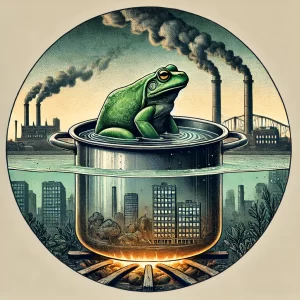 Imagine a frog sitting calmly in a pot of water. The water is gradually heating up, but the change is so subtle that the frog doesn’t notice until it’s too late. This is a perfect metaphor for the economic distress facing the middle class today.
Imagine a frog sitting calmly in a pot of water. The water is gradually heating up, but the change is so subtle that the frog doesn’t notice until it’s too late. This is a perfect metaphor for the economic distress facing the middle class today.
In 1971, 51% of Americans lived in middle class households. By 2023 that share had fallen 10% to 41% according to a Pew Research Center analysis of government data.
Over the past 30 years, the middle class has been subjected to a slow but steady erosion of purchasing power and economic stability. The purpose of this post is to highlight these challenges and encourage readers to seek alternatives for financial growth and stability. Read on to the end of this post to discover exciting alternatives to the challenges you face and learn how you can secure your financial future.
The Economic Squeeze on the Middle Class
Historical Context
Thirty years ago, the middle class enjoyed a relatively stable economic status. The purchasing power of a dollar was significantly higher, and wages were more in line with the cost of living. However, the economic landscape has shifted dramatically.
Devaluation of the Dollar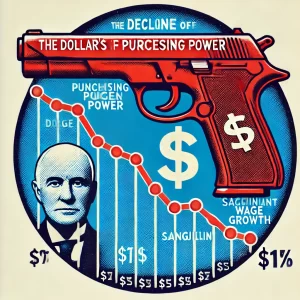
Since 1994, the cumulative inflation rate has reached approximately 96.2%. This means that what $1 could buy in 1994 now requires about $1.96. The Consumer Price Index (CPI) has doubled from 148 to over 305, illustrating how the purchasing power of the dollar has declined. Today, $1 from 1994 is equivalent to just $0.51 in terms of purchasing power.
Stagnation of Wages
Despite the rising costs, wages have not kept pace. Median household income, adjusted for inflation, has seen only a modest increase from about $56,000 in 1994 to around $70,000 in 2024. Real wages have grown by a mere 8% over the past 30 years. Average hourly earnings for non-supervisory and production workers have increased from $14.26 to $25.11, but this increase is modest when adjusted for inflation.
The Rising Cost of Living
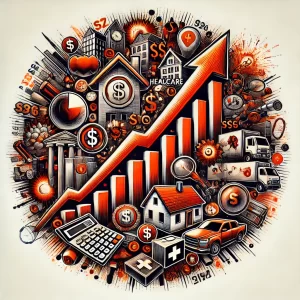 The cost of living has skyrocketed, further squeezing the middle class.
The cost of living has skyrocketed, further squeezing the middle class.
Housing Costs
Housing costs have increased by over 60%, making it harder for the middle class to afford homes.
Healthcare Costs
Healthcare expenses have more than tripled, adding to the financial burden on families.
Education Costs
Education costs have risen by over 150%, making it increasingly difficult for families to invest in their children’s future.
The Additional Tax Burden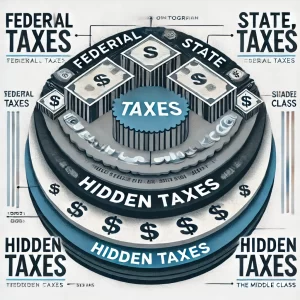
As if rising costs weren’t enough, the average middle-class employee is also shouldering an increasing tax burden due to ballooning federal and state debts. However, these are not the only taxes adding to the financial strain. There are additional, often less visible taxes that significantly impact middle-class income.
Federal Debt Impact
The federal debt has ballooned to over $30 trillion, and servicing this debt requires significant tax revenue. Middle-class taxpayers often bear the brunt of these taxes, which erodes their disposable income.
State Debt and Taxes
Many states have also accrued substantial debt, leading to higher state taxes. These additional taxes reduce the take-home pay of middle-class workers, further squeezing their budgets.
Hidden Taxes
Beyond federal and state income taxes, there are several “hidden” taxes that compound the financial burden on the middle class:
- Sales Taxes: Sales taxes have increased in many states, adding to the cost of everyday goods and services. For example, the average sales tax rate across the U.S. is approximately 7.12%, but in some areas, it can be as high as 10% or more.
- Capital Gains Taxes: Capital gains from the sale of investments such as stocks or real estate are taxed. Long-term capital gains tax rates can be up to 20%, and high earners may also face an additional 3.8% net investment income tax (NIIT) .
- Social Security Taxes: A significant portion of Social Security benefits can be taxable if combined income exceeds certain thresholds. For instance, up to 85% of benefits may be taxable if combined income exceeds $34,000 for single filers or $44,000 for joint filers .
- Medicare Taxes: Income above a certain threshold is subject to an additional 0.9% Medicare tax. Additionally, higher earners may have to pay increased Medicare Part B and Part D premiums, which are effectively a form of tax .
Compounding Effect
The combined effect of these visible and hidden taxes significantly compounds the economic distress faced by the middle class. With more of their income going towards various taxes, middle-class families have less money to save, invest, and spend on essentials, further diminishing their financial stability and growth prospects.
Financial Strain Indicators
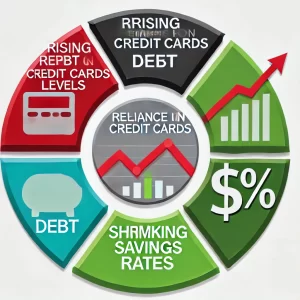 The financial strain on the middle class is evident in several key indicators.
The financial strain on the middle class is evident in several key indicators.
Homeownership Rates
Homeownership rates have declined from about 65% in 1994 to 62% in 2024, indicating affordability issues.
Household Debt
Average household debt has doubled from around $50,000 in 1994 to over $100,000 in 2024.
Savings Rate
Personal savings rates have dropped from about 8% in the early 1990s to around 5% in recent years, leaving families with less financial security.
Comparative Statistics and Implications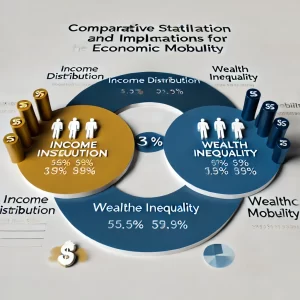
Minimum Wage
While many states have a higher minimum wage, the U. S. Department of Labor federal minimum wage for non exempt employees has increased from $4.25 in 1994 to $7.25 in 2024, but it has not kept pace with inflation, contributing to the economic distress facing the middle class.
Income Inequality
Income inequality has grown significantly. The income share of the top 1% has increased from 10% in 1994 to about 20% in 2024, exacerbating the challenges for the middle class.
The Retirement Savings Crisis
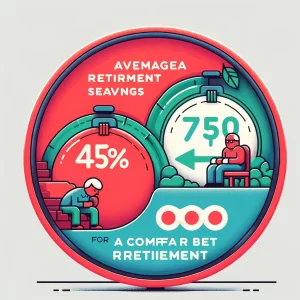 Adding to the economic pressures, the middle class faces a significant retirement savings crisis.
Adding to the economic pressures, the middle class faces a significant retirement savings crisis.
Shift from Defined Benefit to Defined Contribution Plans
In the past, many middle-class employees were offered Defined Benefit Pension Plans, which guaranteed a certain payout upon retirement. However, these have largely been replaced by Defined Contribution Plans, such as 401(k)s, where the payout depends on the amount contributed and the investment performance.
Retirement Savings Statistics
- Retirement Savings Shortfall: According to a study by the National Institute on Retirement Security, the median retirement account balance for near-retirement households is just $12,000.
- Inadequate Savings: Nearly 40% of middle-class households have no retirement savings at all.
- Increased Reliance on Social Security: With insufficient personal savings, many middle-class retirees are heavily reliant on Social Security, which is often inadequate to maintain their standard of living.
Implications of the Shift
The shift to Defined Contribution Plans places the responsibility of retirement savings on individuals, who may not have the financial literacy or resources to manage these effectively. This shift has left many middle-class workers unprepared for retirement, compounding their economic distress.
Understanding the Great Transformation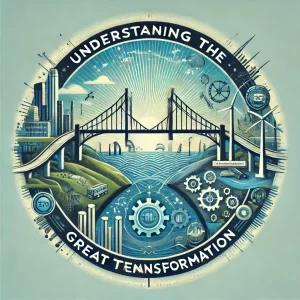
The economic landscape is not only shaped by rising costs, stagnant wages and a raising tax burden, but also by the advent of AI, automation, and robotics. These technologies are ushering in a Great Transformation that will have profound impacts on the middle class. To fully grasp these changes and how to prepare for them, it’s crucial to understand the broader economic shifts at play.
AI, Automation, and Robotics: The Future of Work
Advancements in AI, automation, and robotics are rapidly transforming industries. These technologies promise increased efficiency and productivity, but they also pose a significant threat to traditional employment. Many jobs currently held by middle-class workers are at risk of being automated, leading to job displacement and economic uncertainty.
Impact on the Middle Class
The middle class, already grappling with economic distress, faces additional challenges from this technological transformation. Jobs that once provided stability and a decent income are becoming obsolete. This shift exacerbates the need for alternative income streams and financial resilience.
Preparing for the Transformation
To navigate these changes, it’s essential to stay informed and proactive. Diversifying income sources and developing new skills are critical steps in preparing for the future. Understanding the economic implications of AI, automation, and robotics will help middle-class workers adapt and thrive in a rapidly evolving economy.
For a deeper exploration of these changes and how they impact social productivity, visit our detailed blog post: Transitioning to Social Productivity.
By staying ahead of these trends and investing in your financial education, you can turn potential challenges into opportunities for growth and stability.
The Boiling Frog – Middle Class at a Crossroads
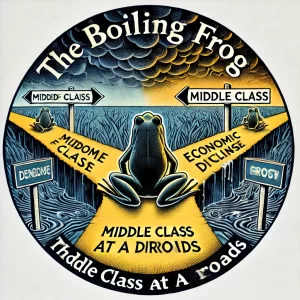 The boiling frog metaphor illustrates how the middle class has been slowly and subtly subjected to increasing economic pressures. Just as the frog fails to notice the rising temperature until it’s too late, many middle-class families have not fully realized the extent of their financial decline until it becomes critical.
The boiling frog metaphor illustrates how the middle class has been slowly and subtly subjected to increasing economic pressures. Just as the frog fails to notice the rising temperature until it’s too late, many middle-class families have not fully realized the extent of their financial decline until it becomes critical.
Seeking Alternatives for Financial Growth
To escape this metaphorical boiling pot, the middle class must seek alternatives for financial growth and stability.
Introduction to Passive and Residual Income
Passive and residual income streams are essential in today’s economy. These income sources provide financial security and independence, allowing individuals to weather economic fluctuations.
Benefits of Diversifying Income Streams
Diversifying income streams can significantly enhance financial resilience. By not relying solely on traditional employment, individuals can build a more robust financial foundation.
Solution – Enrolling in “Mastering the Art of Wealth Creation”
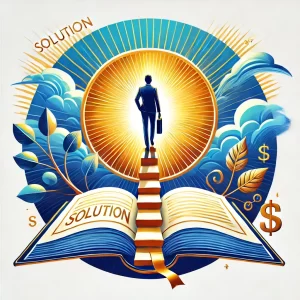 Our course, “Mastering the Art of Wealth Creation: A Journey Through Mind Power and Marketing,” offers a comprehensive solution. Click here to learn more.
Our course, “Mastering the Art of Wealth Creation: A Journey Through Mind Power and Marketing,” offers a comprehensive solution. Click here to learn more.
Course Introduction
This course is designed to help middle-class employees grow their passive, residual income and accumulate wealth.
Course Benefits
Participants will learn strategies for wealth creation, financial growth, and stability, tailored to the unique challenges facing the middle class.
Success Stories
Although our course has just been released, it has already begun to make a significant impact. Early participants are discovering the transformative power of mastering wealth creation techniques, finding valuable information, training, and support to explore alternatives to their current employment situations.
Conclusion
Call to Action
The economic distress facing the middle class is real and urgent. It’s time to take control of your financial future. Enroll in our course to learn strategies for growing your passive, residual income and achieving financial stability.
Final Thought
The boiling frog analogy serves as a stark reminder of the need for proactive financial decisions. Don’t wait until it’s too late—take action now to secure your financial future and avoid becoming another victim of the disappearing middle class.

John Rogers is a former Wall Street portfolio manager and served as CEO of Premium Enterprises and President of The Colorado Tire Recycling Center. He transitioned to digital marketing, founding WealthCreationMastermind.com to empower home-based entrepreneurs with cutting-edge strategies. Creator of the “Mastering the Art of Wealth Creation” online course, John has driven significant growth in network marketing, achieving the Blue Diamond rank and earning the title of Univera Associate of the Year in 2015. His expertise in leveraging technology for financial success transforms how entrepreneurs achieve their business goals.